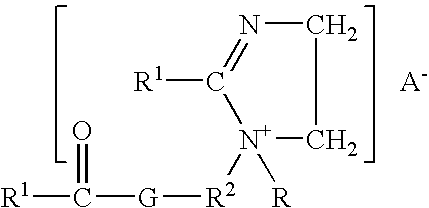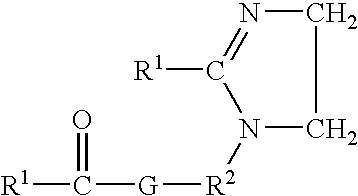Clear or translucent aqueous fabric softener compositions containing high electrolyte content and optional phase stabilizer
- Summary
- Abstract
- Description
- Claims
- Application Information
AI Technical Summary
Benefits of technology
Problems solved by technology
Method used
Image
Examples
Embodiment Construction
A. Fabric Softener Actives
Typical levels of incorporation of the softening compound (active) in the softening composition are of from 2% to 80% by weight, preferably from 5% to 75%, more preferably from 15% to 70%, and even more preferably from 19% to 65%, by weight of the composition, and preferably is biodegradable as disclosed hereinafter.
As has been previously disclosed in U.S. Pat. No. 5,759,990, issued Jun. 2, 1998 in the names of E. H. Wahl, H. B. Tordil, T. Trinh, E. R. Carr, R. O. Keys, and L. M. Meyer, for Concentrated Fabric Softening Composition with Good Freeze / Thaw Recovery and Highly Unsaturated Fabric Softener Compound Therefor, and in U.S. Pat. No. 5,747,443, issued May 5, 1998 in the names of Wahl, Trinh, Gosselink, Letton, and Sivik for Fabric Softening Compound / Composition, it has been found that softener actives with alkyl chains that are unsaturated or branched are particularly well suited for use in clear or translucent aqueous fabric softener compositions. An...
PUM
 Login to View More
Login to View More Abstract
Description
Claims
Application Information
 Login to View More
Login to View More - R&D
- Intellectual Property
- Life Sciences
- Materials
- Tech Scout
- Unparalleled Data Quality
- Higher Quality Content
- 60% Fewer Hallucinations
Browse by: Latest US Patents, China's latest patents, Technical Efficacy Thesaurus, Application Domain, Technology Topic, Popular Technical Reports.
© 2025 PatSnap. All rights reserved.Legal|Privacy policy|Modern Slavery Act Transparency Statement|Sitemap|About US| Contact US: help@patsnap.com



